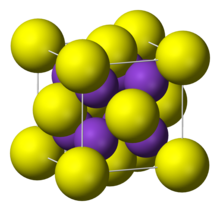Caesium sulfide
Appearance

| |
| Names | |
|---|---|
| IUPAC name
Caesium sulfide
| |
| Identifiers | |
3D model (JSmol)
|
|
| ChemSpider | |
PubChem CID
|
|
CompTox Dashboard (EPA)
|
|
| |
| |
| Properties | |
| Cs2S | |
| Molar mass | 297.876 |
| Appearance | white crystal |
| Density | 4.19 g·cm−3[1] |
| Melting point | 480 °C[2] |
| hydrolyses to form caesium bisulfide[3] | |
| Solubility in ethanol and glycerol | soluble |
| Structure | |
| cubic, anti-fluorite | |
| Hazards | |
| Occupational safety and health (OHS/OSH): | |
Main hazards
|
toxic |
| GHS labelling: | |
 
| |
| Danger | |
| H314, H400 | |
| P260, P264, P273, P280, P301+P330+P331, P303+P361+P353, P304+P340, P305+P351+P338, P310, P321, P363, P391, P405, P501 | |
| Related compounds | |
Other anions
|
caesium oxide caesium selenide caesium telluride caesium polonide |
Other cations
|
potassium sulfide, lithium sulfide, rubidium sulfide, sodium sulfide, francium sulfide |
Except where otherwise noted, data are given for materials in their standard state (at 25 °C [77 °F], 100 kPa).
| |
Caesium sulfide is an inorganic salt with a chemical formula Cs2S. It is a strong alkali in aqueous solution. In the air, caesium sulfide emits rotten egg smelling hydrogen sulfide.
Production
Similar to sodium sulfide, anhydrous caesium sulfide can be produced by reacting caesium and sulfur in THF. It needs ammonia or naphthalene to react.[4]
- 2Cs + S → Cs2S
By dissolving hydrogen sulfide into caesium hydroxide solution, it will produce caesium bisulfide, then it will produce caesium sulfide too.[5][6]。
- CsOH + H2S → CsHS + H2O
- CsHS + CsOH → Cs2S + H2O
References
- ^ Sommer, Helmut; Hoppe, Rudolf. The crystal structure of cesium sulfide and a remark about cesium selenide, cesium telluride, rubidium selenide, and rubidium telluride (in German). Zeitschrift fuer Anorganische und Allgemeine Chemie, 1977. 429: 118-30. ISSN: 0044-2313
- ^ Dale L. Perry, Sidney L. Phillips: Handbook of inorganic compounds. CRC Press, 1995, ISBN 978-0-8493-8671-8, S. 336 ([1], p. 336, at Google Books).
- ^ Jean D'Ans, Ellen Lax: Taschenbuch für Chemiker und Physiker. 3. Elemente, anorganische Verbindungen und Materialien, Minerale, Band 3. 4. Auflage, Springer, 1997, ISBN 978-3-5406-0035-0, S. 692 ([2], p. 692, at Google Books).
- ^ J.-H. So and P. Boudjouk (1992). N. G. Russell (ed.). "Hexamethyldisilathiane". Inorganic Syntheses. doi:10.1002/9780470132609.ch11.
- ^ Wilhelm Blitz, Ernst Wilke-Dörfurt: "Über Sulfide des Rubidiums und Cäsiums" in Zeitschr. f. anorg. Chem. 1906. 48, S. 297–317. Volltext
- ^ R. Abegg, F. Auerbach: 'Handbuch der anorganischen Chemie'. Verlag S. Hirzel, Bd. 2, 1908. S. 430.Volltext
